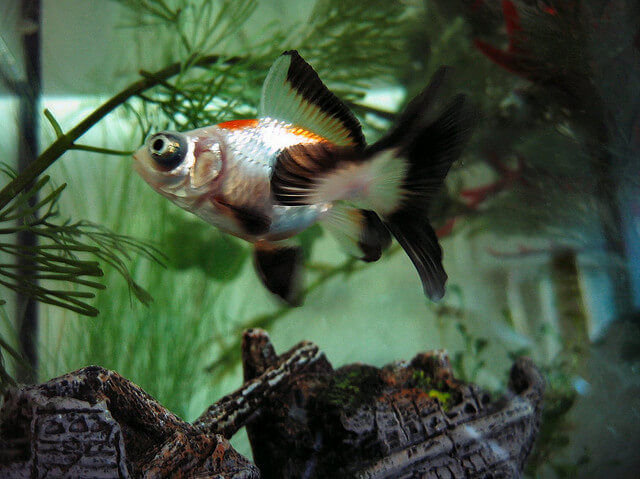The Telescope Goldfish, also known as the Globe Eye Goldfish or Dragon Fish, is a fascinating and visually striking variety of fancy goldfish. Renowned for its unique protruding eyes, this breed captures the attention of goldfish enthusiasts worldwide. In this article, we will explore the distinct physical characteristics, color variations, and specific care requirements of the Telescope Goldfish.

Unique Physical Features
The Telescope Goldfish is easily distinguishable by its prominent globe-shaped protuberance and protruding eyes. These eyes begin to develop around six months of age and are positioned on the outermost tips of the fish’s globe-shaped head. A high-quality Telescope Goldfish should exhibit good symmetry, with each eye ideally located at the outermost tip of the globe-shaped protuberance.
In terms of body structure, the Telescope Goldfish shares similarities with the Veiltail Goldfish. It possesses a short, deep, and rounded body shape, which adds to its overall charm. Unlike other goldfish breeds, the Telescope Goldfish has pointed, paired fins, including the caudal tail fin. The dorsal fin is positioned high on the back, resembling the slight elevation seen in Ryukin Goldfish. When in motion, the dorsal fin should remain sturdy and upright, accentuating the fish’s gracefulness.
Distinctive Caudal Fins
The Telescope Goldfish boasts fully divided caudal fins, which should ideally measure about three-quarters the length of its body. These caudal fins are forked, with each fin divided into two distinct lobes. The elegant flow and movement of the caudal tail fins resemble those of the Oranda Goldfish, contributing to the Telescope Goldfish’s beauty and appeal.
Vibrant Color Variations
Telescope Goldfish come in a wide range of captivating colors, making them a delightful addition to any aquarium or pond. The color variations include:
- Self-Colored: These Telescope Goldfish exhibit a single solid color, such as red, blue, chocolate, or white.
- Bi-Colors: Bi-color Telescope Goldfish feature a combination of two colors, most commonly black/white or red/white.
- Calico: Calico Telescope Goldfish have a distinct pattern with a blue background and a symmetrical balance of vibrant colors, including bright brown, orange, red, yellow, and violet patches. Small black spots may also appear over their entire bodies.
Varieties and Companions
In addition to the standard Telescope Goldfish, there are specific varieties that have gained popularity among enthusiasts. The Panda Butterfly Telescope is predominantly black and white, creating a striking contrast in appearance. Another well-known variety is the Broadtail Moor or Black Moor Goldfish, which has a velvety black coloration.
When considering companions for the Telescope Goldfish, it’s important to note that they are not suitable for outdoor goldfish ponds. Their poor vision makes it challenging for them to compete for food with other goldfish breeds. Additionally, their protruding eyes make them more susceptible to infections and injuries. Therefore, it is recommended to keep Telescope Goldfish among other slow-moving or delicate breeds that pose minimal risk to their well-being.
Proper Care and Maintenance
To ensure the health and well-being of your Telescope Goldfish, it is essential to provide optimal care. Here are some key care tips to follow:
Tank Size: Provide a spacious aquarium with a capacity of at least 20 gallons per fish to accommodate their active swimming and growth.
Water Conditions: Maintain clean and well-filtered water with a pH level between 6.5 and 7.5, and a temperature range of 65-75°F (18-24°C). Perform regular water changes to prevent ammonia and nitrate buildup.
Diet: Offer a balanced diet to meet the nutritional needs of your Telescope Goldfish. Provide a combination of high-quality flakes, pellets, and occasional treats such as bloodworms, brine shrimp, or daphnia. Ensure that the food is appropriate in size for their small mouth and that they are not overfed to prevent digestive issues and obesity.
Tank Setup: Create a suitable environment for your Telescope Goldfish by adding hiding places, plants (both live and artificial), and smooth substrate to prevent injury to their delicate fins. Avoid sharp decorations or rough surfaces that could harm their protruding eyes.
Water Quality: Monitor and maintain excellent water quality by performing regular water tests for parameters such as ammonia, nitrite, nitrate, and pH levels. Perform partial water changes of around 20-30% every week to keep the water clean and free from pollutants.
Compatibility: When choosing tankmates for your Telescope Goldfish, select slow-moving and peaceful fish species that won’t compete for food or harass your goldfish. Good choices include other fancy goldfish varieties such as Ryukins, Orandas, or Lionheads.
Observation and Health Care: Regularly observe your Telescope Goldfish for any signs of illness, such as loss of appetite, abnormal swimming behavior, or visible lesions. If you notice any issues, consult with a qualified aquatic veterinarian or seek advice from reputable fishkeeping resources to address the problem promptly.
Sources:
- Stoskopf, M. K. (1993). Goldfish Varieties and Genetics: Handbook for Breeders. Tropical Fish Hobbyist Publications.
- Andrews, C. (2004). An Interpet Guide to Fancy Goldfish. Interpet Publishing.
- Hickling, C. F., & Hickling, M. K. (2006). Goldfish Varieties and Genetics: A Handbook for Breeders. TFH Publications.
Reviewed By: Tim Winter

Tim Winter has a strong affection for pets and wildlife. His years of experience caring for various types of pets has led him to share his knowledge with others on the best practices in pet care. Tim holds a Bachelor of Science from the University of Oregon School of Journalism and Communications.
